Reishi Mushroom: The Ultimate Guide To Ganoderma Lucidum
Contents
- What is Reishi Mushroom?
- How Are Reishi Mushrooms Grown?
- What Compounds Are in Reishi?
- How are Active Reishi Compounds Isolated?
- What are the Benefits of Reishi Mushrooms?
- Reishi Mushroom Spores: A Hidden Powerhouse
- How to Use Reishi Mushroom
- How Much Reishi Mushroom Should I Take?
- How Long Does it Take for Reishi Mushroom to Work?
- Can Reishi Mushroom Have Side Effects or Interactions?
- What is the Best Reishi Mushroom Supplement?
- Take Reishi for Your Health!
Reishi mushroom is a rich source of natural compounds with the power to boost immunity, smack down stress and cool inflammation.*
Known by some cultures as the “mushroom of immortality,” Reishi mushroom has been used for thousands of years to increase vitality, bolster the immune system, support cardiovascular health and promote longevity*.
Does it live up to its reputation? Can taking Reishi mushroom supplements really promote internal balance and turn the immune system into an unstoppable powerhouse?
We combed through the history and science of Reishi to unlock its secrets—and we’ll walk you through our discoveries in this guide!
What is Reishi Mushroom?
Ganoderma lucidum — commonly known as Reishi — is a beautiful, unique specimen among fungi. Also called lingzhi (the divine or spirit mushroom) in China and mannetake (the mushroom of immortality) in Japan, Reishi has long been revered for its medicinal properties.
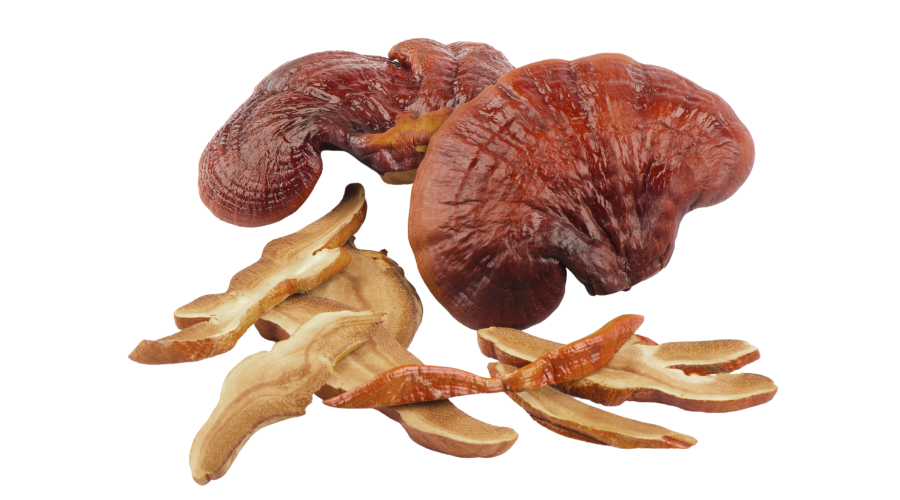
Reishi in Medicine: A Brief History Lesson
Asian cultures have used Reishi mushroom in medicine for thousands of years. In traditional Chinese medicine (TCM), it’s part of a group called “Fu Zheng,” which includes herbs and foods considered to be some of the most powerful for improving strength, health and longevity*.[1]
The Classics of the Materia Medica—written in the Eastern Han dynasty (25-220AD)—references the mushroom, and it’s still listed in the State Pharmacopoeia of the People’s Republic of China as a remedy for several conditions.
Before major supplemental cultivation began in the 1970s, Reishi was relegated to the realm of nobility. Its relatively uncommon appearance in the wild made the mushroom a prized commodity, giving it an almost mystical halo and a price point only the rich could afford.
Today, medicinal Reishi mushrooms are available in a variety of forms, including supplements, beverages and functional foods.
Traditional Benefits of Ganoderma Lucidium
What was Reishi traditionally used for? Most of the purported medicinal properties stem from a belief that the mushroom can create balance by influencing energy and vitality*.
Referred to as “tonifying” in TCM, Ganoderma lucidum‘s balancing properties were believed to positively affect heart health, improve memory, ease stress, heal respiratory problems and even combat aging*.
There are several other Ganoderma species, including G. applanatum, G curtisii, G. Oregonese, G. Sessile, G. Tsugae and more.
Each mushroom grows well in different areas and on different types of wood. Although Ganoderma lucidum is the main species used in supplements and research, science is beginning to reveal potential health properties in other types, as well.
What Does Reishi Mushroom Look Like?
You won’t find Reishi poking out of the ground in a typical stem and cap shape. Instead, they grow on dead or dying hardwood trees in either “antler” or “conk” form.
These growths are known as the fruiting body of the mushroom.
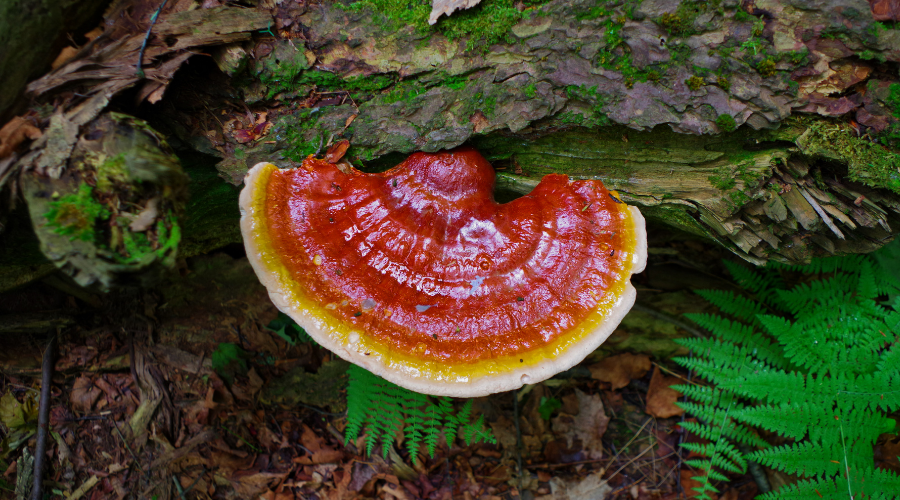
Because Reishi mushrooms grow out and not up, they’re known as bracket fungi or shelf fungi (although when cultivated, they can definitely be made to grow “up”).
The mushroom is also classified as a “polypore,” meaning that, rather than gills, the underside is composed of thousands of pores and is lined with cells called basidia that make spores.
When it’s time for Reishi mushrooms to reproduce, the basidium release the spores into the air for dispersal to new areas.
The Shiny Specimen
Young Reishi starts off white, and the underside retains this color. The kidney-shaped conk, however, turns red or orange and develops a sheen as it grows.
In fact, Ganoderma means “shiny skin,” and the wet or painted appearance has earned the mushroom the nickname of “varnished conk.”
The sheen fades as the mushrooms age, making older specimens look dull. Dullness may also indicate recent spore release; some spores settle pretty close to home!
How big can Reishi get? It’s normal for conks to be 1 to 2 inches thick and less than 12 inches across, but they can get much larger under certain conditions.
A lot larger. Check out the story behind this mind-boggling Reishi conk!
How Are Reishi Mushrooms Grown?
Ganoderma lucidum appears in the wild between May and early autumn, “feeding” on wood and playing an active role in the natural process of decay.
Compounds in the wood can directly influence concentrations of active compounds in mature mushrooms,[3] which may result in unique combinations and variations from one location to another.
However, most Reishi used in supplements is cultivated on outdoor farms, in shade houses or in greenhouses, using either logs or sawdust fruiting blocks.
Cultivated Reishi starts out in the antler form before maturing into conks. The mushrooms love warm weather, so summer temperatures between 70 F and 80 F are optimal for growth.
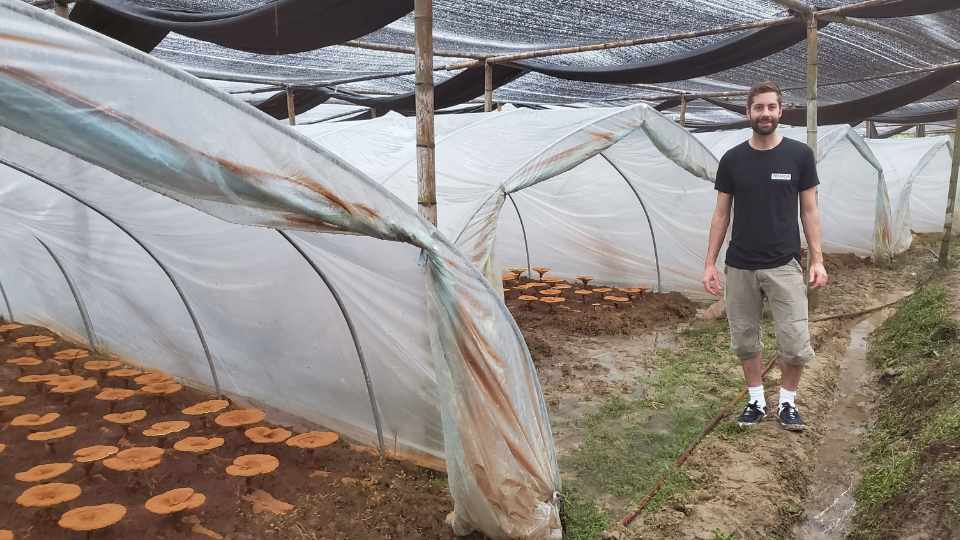
Fully grown Reishi mushrooms provide the greatest health benefits, which means waiting about nine months to harvest fruiting bodies grown on wood. The Reishi must be kept warm and moist throughout the process to ensure a successful harvest.
What Compounds Are in Reishi?
Researchers have extracted and identified two major beneficial components from Reishi mushrooms: beta-glucans and triterpenes.
Beta-Glucan Basics
Beta-glucans (or beta-d-glucans) are found at high levels in Reishi fruiting bodies. They’re a type of water-soluble complex carbohydrates called polysaccharides that also function as fermentable fiber, meaning they survive digestion and are broken down by gut microbes in the colon.
Beta-glucans’ complexity is due to their molecular structure, which consists of carbon chains sporting branches or side chains. Differences in side chain arrangement may be the reason why beta-glucans found across the fungal kingdom appear to have different functions.[4]
When beta-glucans are linked to proteins, they form polysaccharide peptides like those found in Reishi mushrooms. It’s possible that medicinal potency could be related to the degree of molecular complexity.
Triterpene Traits
Triterpenes aren’t soluble in water; instead, they require alcohol or fat for the body to break them down and extract the benefits.
Ganoderic acid is the main triterpenoid found in Ganoderma species and is responsible for the mushrooms’ bitter flavor.
So far, research has uncovered over 100 triterpenes in Reishi alone, at least 50 of which aren’t found in other fungi.
These complex molecules—which are made up of carbon, hydrogen, oxygen and sulfur atoms[5]— come in various types and have different functions. Specific ganoderic acids, such as ganoderic acid A[6], have been associated with beneficial activities.
Sterol Strengths
Sterols act as hormone precursors—inactive compounds that become functional hormones when activated.[7]
In humans, cholesterol is the most well-known of these molecules.
Reishi produces numerous sterols, including ergosterol, the precursor to vitamin D. The diverse sterol content is still being studied in relation to its effects on human health.[8]
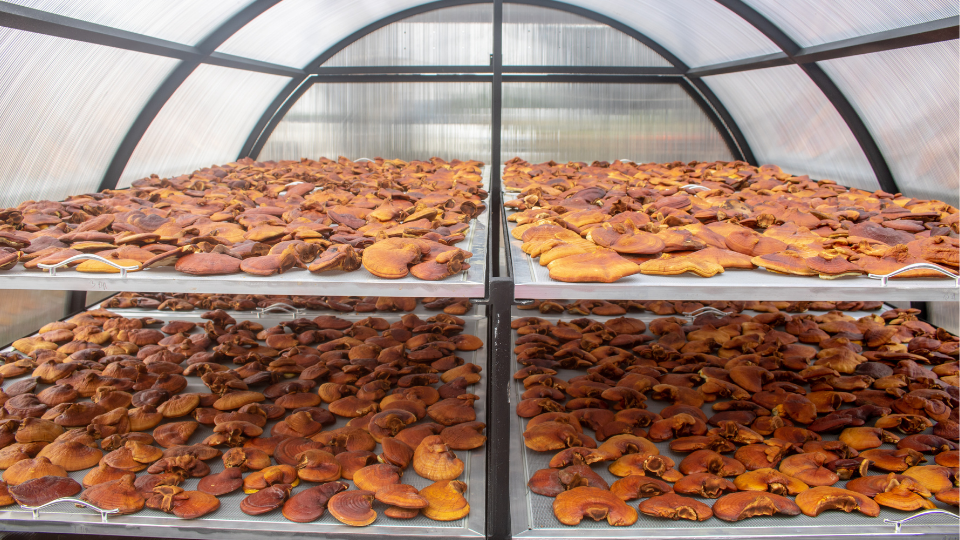
How are Active Reishi Compounds Isolated?
Breaking through the tough cellular walls to release beta-glucans and triterpenes requires a specialized extraction process.
Reishi mushroom supplements are made using alcohol extraction, water extraction or a combination of both (known as dual extraction).
Alcohol extraction is sort of like a steeping or tincture-making process in which Reishi is soaked in alcohol for several weeks; the triterpenes come out in the alcohol. In water extraction, fresh Reishi is simmered in vats for a few hours to draw out the beta-glucans.
Combining the resulting extracts creates a final product in liquid or powder form that contains as many beneficial Reishi compounds as possible.
Using the fruiting body ensures the highest concentration of beta-glucans and triterpenes.
What are the Benefits of Reishi Mushrooms?
Reishi’s reported health benefits are nothing short of impressive.
That’s why it is the most commonly used medicinal mushroom in the world.
Research into the purported health effects is ongoing as scientists seek to uncover the exact mechanisms of action that make Ganoderma lucidum so powerful.
There’s plenty of information out there touting what Reishi mushroom is good for, but what does the science say? A growing body of rigorous studies is available evaluating Reishi’s reported health benefits.
Here’s what the research shows on 10 potentially powerful effects of medicinal Reishi mushrooms on health.
1. Stimulates and regulates the immune system*
Reishi’s immunological effects are one of its most cited and celebrated properties and can be thought of as the core or foundation of the mushroom’s other benefits.
Studies show Reishi may support the immune system by:
- Affecting white blood cell genes to increase production of natural killer cells*
- Increasing T cell and B cell counts to strengthen cell-mediated immunity and improve antibody response*[9]
- Activating interleukin gene expression to regulate immune responses*
- Boosting tumor necrosis factor production to regulate cell cycles, including cell death*[10]
- Reducing the inflammatory responses involved in allergic reactions*
2. May reduce inflammation*
Inflammation gets a bad rap, but it’s actually a beneficial process.
When an injury occurs or pathogens invade, the body sends out an army of immune cells to address the problem. The resulting inflammatory cascade can cause symptoms like pain, swelling and redness.
The process is supposed to stop once the trigger is taken care of. When it doesn’t, a chronic inflammatory reaction develops. The resulting damage appears to play a role in a significant number of chronic and age-related conditions.
One animal study showed a specific protein from Reishi can help modulate the immune system’s response by increasing anti-inflammatory cytokine and regulatory T-cell production*.[16] Some studies on cancer[17, 18] show terpenes may also have anti-inflammatory effects*.[19]
However, not all Reishi research agrees on these benefits:
- One study on healthy subjects receiving commercially prepared Reishi capsules showed no changes in biomarkers related to inflammation.[20]
- Another study revealed a marked increase in plasma antioxidant capacity after supplementing with Reishi.[21]
It’s possible some of these conflicts may be due to how different Reishi preparation methods can affect levels of beneficial compounds.
3. Promotes cardiovascular health*
Any weapon that could be added to the arsenal in the fight against the world’s number one killer—heart disease—is worth investigating. Research into this aspect of Reishi mushroom health benefits is mixed but shows some promising effects.
According to studies:
- Reishi may positively affect blood lipid levels,[22] although results may differ for people with other chronic conditions like diabetes*[23]
- Antioxidant activity could reduce or prevent lipid peroxidation, which is the first step in plaque formation*[24]
- Taking Reishi mushrooms could favorably influence blood pressure*
- Reishi has the potential to prevent heart damage from chronic disease and unhealthy lifestyle factors*[25]
Some evidence indicates these mushrooms may also offer additional benefits by lowering LDL and total cholesterol levels, reducing triglyceride production and increasing HDL*.[26, 27]
The mechanism of action here isn’t clear, but researchers think the collective effects of beta-glucans and triterpenes may play a role by mediating oxidative stress, thus decreasing the risk of cellular damage*.
4. Improves sleep*
According to the American Sleep Association, 37% to 40% of adults ages 20 to 59 say they don’t get enough sleep.
Sleep deprivation can have some serious side effects, including reduced productivity, a greater likelihood of getting in car accidents and increased risk of developing chronic diseases.
Taking Reishi mushroom for sleep could help prevent these problems*. Triterpenes appear to have positive effects on sedation,[28] which can:
- Make it easier to fall asleep*
- Improve sleep quality*[29, 30]
- Provide the body with more opportunities for repair and recovery*
That’s why some people swear by having Reishi mushroom tea before bed!
5. Reduces anxiety and stress*
Some of the same properties that make Reishi good for sleep may also reduce overall stress, allowing for a better response to emotional triggers*.
Animal studies suggest potential anti-depressant activity, which in turn may reduce or protect against symptoms of anxiety*.[31]
One study of breast cancer patients showed those receiving Reishi mushroom spore powder reported “less anxiety and depression and better quality of life*.”[32] This suggests additional benefits of Reishi mushrooms for those experiencing disease-related struggles with mood and mental well-being*.
6. Protecting the brain*
Brain aging and beta-amyloid plaque formation appear to go hand in hand.[33]
Buildup of these proteins is thought to be the first step in cognitive decline and is a major characteristic of Alzheimer’s.
Reishi may help in this fight by:
- Protecting neurons from dying*
- Reducing or preventing beta-amyloid-induced inflammation*
- Inhibiting the toxic effects of beta-amyloid on synapses*[34]
- Reducing brain inflammation to prevent cell alterations associated with brain aging*[35]
It’s likely these effects are associated with Reishi’s overall anti-inflammatory activity*.
7. Balances hormones*
Because hormones are involved in everything from metabolism and appetite to sleep cycles and temperature,[36] keeping everything in balance is critical.
What do Reishi mushrooms do for hormones? It appears the active compounds have a normalizing effect on hormone levels*. Studies show this may give Reishi the ability to:
- Regulate estrogen receptor hormones, which could help protect against breast cancer and other estrogen-related cancers*[37]
- Improve the state of the lymphatic system and endocrine organs in immunocompromised patients*[38]
- Reduce 5-alpha-reductase levels to prevent testosterone from converting to dihydrotestosterone (DHT), a stronger form which is sometimes associated with increased risk of prostate disease*[39, 40]
- Reduce prostate-specific antigen (PSA) levels in cases of benign prostatic hyperplasia (enlarged prostate)*[41]
Support health by exhibiting estrogen-like activity in individuals with low estrogen levels, such as post-menopausal women*.[42]
8. May prevent liver damage*
Data on Reishi mushroom and liver health is conflicting. Although some potential toxicity was found in certain supplements in the past, Reishi itself could actually be hepatoprotective*.
Research in this area indicates potential benefits in people suffering from liver injuries or hepatitis B, possibly due to positive effects on the immune response*.[43] Reishi may also inhibit cells that play key roles in liver fibrosis*.
9. May stabilize blood sugar*
When tested in diabetic mouse models, Reishi mushroom beta-glucans appeared to have beneficial effects*. However, human research results are mixed. As of yet, science hasn’t been able to pinpoint a clear benefit for blood sugar control in diabetics or people suffering from metabolic syndrome.[44]
10. May promote healthy gut bacteria balance*
Research into Ganoderma benefits for the gut microbiome is still in its infancy, but one mouse study showed potentially positive results*. Giving a water-extracted Reishi preparation to mice fed high-fat diets reversed gut dysbiosis and protected against metabolic endotoxemia*.[45]
In other words, Reishi may restore gut balance and prevent bacterial toxins from ending up in the bloodstream*. These results suggest Reishi could be a helpful ally in the fight against obesity and insulin resistance, but more studies are needed to know for sure*.
Reishi Mushroom Spores: A Hidden Powerhouse
Spores are to mushrooms what seeds are to plants. Instead of stems giving rise to flowers and flowers producing fruits, an underground network of rootlike fibers called mycelium gives rise to the fan-shaped fruiting body and its basidia cells.
But the fruiting body—which is essentially a reproductive organ—isn’t the only place where mushroom magic happens.
Spore Science
Reishi spores are widely used in Asian medicine but haven’t yet been the subject of extensive study in Western cultures.
Current research shows spores contain both polysaccharides and triterpenes, including ganopsoreric acid and multiple types of ganoderic acids*.[46]
Scientists are continuing to isolate and analyze additional compounds for potential health benefits. Harnessing the antioxidant activity of known compounds along with new discoveries could yield novel treatments for common medical conditions*.
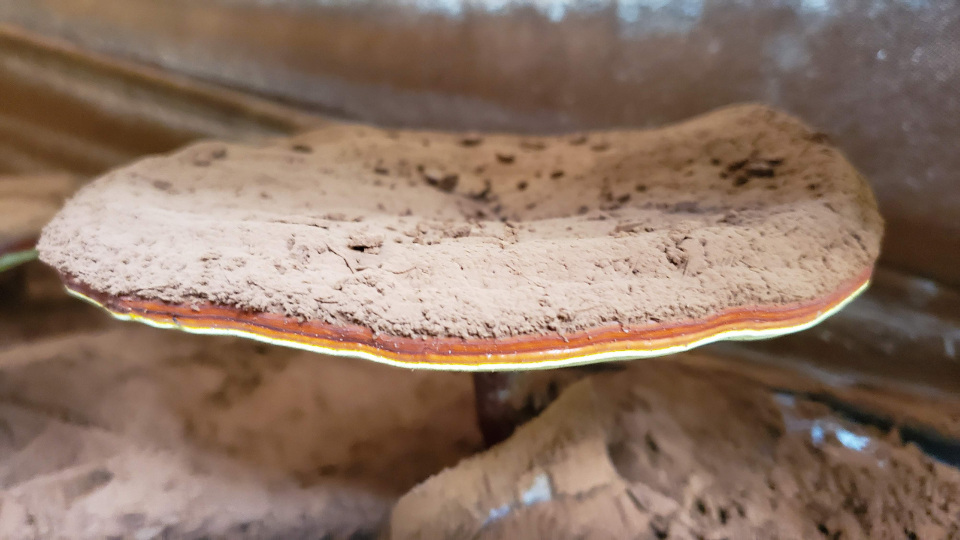
Unlocking Spore Benefits
Getting beneficial compounds out of Reishi mushroom spores is a little trickier than making extracts from the fruiting body. To reap the health benefits, spores must be “cracked” using methods like fermentation, ultrasound or milling*. Spores can be made into a powder or processed further to extract spore oil once the skins have been removed.
Although Reishi spores are touted for their high potency and health benefits, low extraction rates often translate into high price tags for spore-derived products, making them less accessible than fruiting body extracts*.
How to Use Reishi Mushroom
There’s a reason Reishi isn’t found with other mushrooms in the produce department: The conk is tough and woody, and the taste is extremely bitter, making the mushroom inappropriate for culinary use.
Using Reishi mushroom powder, capsules or tinctures is the easiest way to get past these characteristics. Powders are especially versatile; they can be used in recipes or combined with other mushrooms for additional benefits.
Beware of commercially available functional food products claiming to contain Reishi. Some manufacturers “fairy dust” their products, adding just enough of a popular ingredient to be able to tout special benefits.
These products may taste good, but they can’t match the power of supplementing with Reishi mushroom at supportive or therapeutic levels*.
How to Make Reishi Mushroom Tea
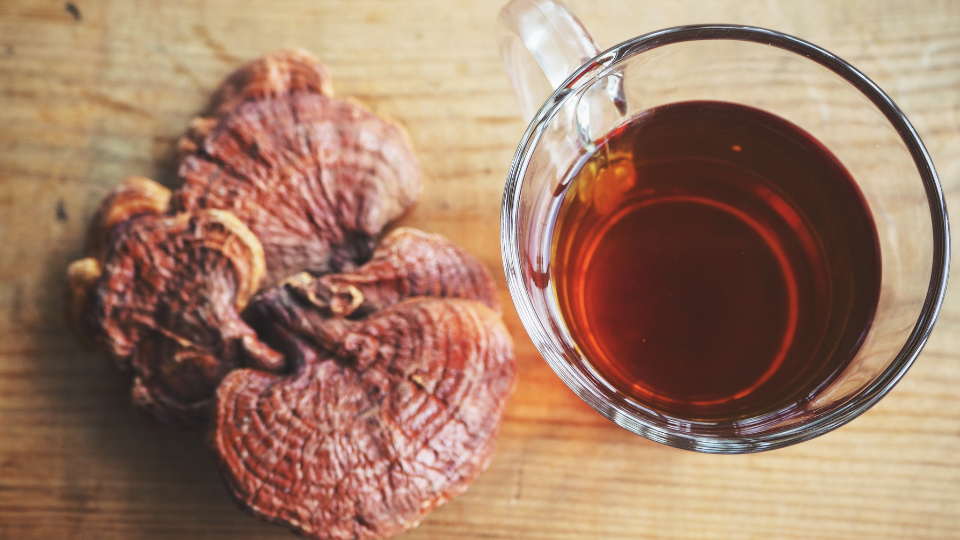
Tea is another popular delivery method for the magic of Reishi.
It’s similar to a hot water extract, which delivers the medicinal benefits of the mushroom fruiting body in a bitter tasting tea. It can be “enjoyed” hot or brewed in large batches and placed in the fridge for use throughout the week.
To brew Reishi mushroom tea at home:
- Start with fresh or dried Reishi fruiting bodies (antlers or conks)
- Carefully cut the mushrooms into strips or pieces
- Boil four cups of water for every 5 grams of dried or 25 to 30 grams of fresh Reishi
- Add the cut Reishi, reduce the heat and simmer for 2 hours
- Remove the pot from the heat, and cool the tea to room temperature
- Strain and drink up to 8 ounces per day
Reishi tea is definitely an acquired taste, but it’s worth acquiring to get all the benefits of this powerful mushroom!
Can’t get past the bitterness? Try mixing prepared Reishi tea into your daily cup of coffee or experimenting with add-ins like honey, ginger and/or turmeric.
How Much Reishi Mushroom Should I Take?
A general rule of thumb for how much Reishi to take is somewhere between 500 milligrams and 2,000 milligrams per day, but the ideal amount depends on a variety of factors, including the extraction method and form*.
Dual-extracted Reishi mushroom supplements have higher concentrations of beneficial compounds, making them effective at lower doses*. Using both water and alcohol extraction also ensures the final preparation contains both beta-glucans and triterpenes.
Evidence suggests Reishi can be safe in daily doses of up to 9 grams*.[47]
As with any natural supplement, a word of caution: Because research is ongoing and studies don’t always agree, it should never be used to “treat” a medical problem. Avoid self-diagnosing, especially if symptoms could indicate a serious condition.
Reishi may also cause physiological changes that can be dangerous when taken in conjunction with certain medications. Consult a doctor or natural health care practitioner for guidance on making this mushroom part of the regimen for any specific condition.
What Time of Day Should I Take Reishi?
Since Reishi mushroom doesn’t need to be taken with food, it’s suitable for any time of day. The choice is largely up to personal preferences and desired outcomes.
Here are a few optimal times to try Reishi for best results:
- On the morning of a busy day to tackle work with less anxiety*
- Every morning during allergy season to minimize symptoms*
- Before traveling for extra immune support*
- As a tea before bed to promote a good night’s sleep*
Consistency is the key to reaping the greatest Ganoderma lucidum benefits. The body needs time to react to the bioactive compounds, so effects may become more noticeable over time.

How Long Does it Take for Reishi Mushroom to Work?
Medicinal mushrooms aren’t “quick fix” solutions; they act as ongoing support for the body.
The full spectrum of benefits might not be apparent right away, especially since many are internal.
While some perks—like better sleep—may be felt right away, the effects of damaged cells being cleared and reduction of oxidative stress can take longer to manifest*.
What to Expect from Ganoderma Lucidum Supplements
Regular users of Reishi mushroom may:
- Feel more relaxed*
- Be better rested*
- Get sick less often*
- Have fewer allergy symptoms*
- Feel more balanced emotionally*
Unless it causes side effects, the mushroom can be a regular part of a natural health regimen.
A note on medicinal mushroom blends: Products containing other mushrooms along with Reishi can have additional benefits and support for overall well-being, but Reishi should be taken alone when more targeted results are desired.
Can Reishi Mushroom Have Side Effects or Interactions?
Reishi supplements are generally regarded as safe when taken at typical doses for up to one year*. However, not everyone reacts the same, and supplementing with this mushroom may not be suitable in some cases.
Potential Side Effects of Reishi
Symptoms may emerge after taking Reishi supplements consistently for three to six months. These side effects can include:
- Dry mouth, throat and nose
- Itching and/or rash
- Nausea and/or diarrhea
- Dizziness
- Headache
- Nosebleed
On rare occasions, Reishi may cause:
- Sore throat
- Runny nose
- Insomnia
Some complications may be due to Reishi’s effects on blood pressure or blood sugar, which is why it’s important for anyone with a medical condition to check with a doctor before supplementing.
Interactions Between Reishi and Prescription Medications
Potentially serious health problems may result if Reishi is taken with certain prescriptions:[48, 49]
- Blood pressure medications coupled with Reishi may cause blood pressure to drop too low
- Anticoagulants or antiplatelet drugs along with large supplemental doses of Reishi can affect blood clotting and cause bruising or bleeding
- Diabetes medications and Reishi can cause unhealthy drops in blood sugar
It’s also important to exercise caution when taking herbs or supplements with physiological effects similar to Reishi, including:
- Andrographis, casein peptides, Cat’s Claw, CoQ10, fish oil, L-arginine, lycium, and stinging nettle for lower blood pressure
- Angelica, anise, arnica, clove, danshen, garlic, ginger, ginkgo, Panax ginseng, horse chestnut, red clover and turmeric to prevent clotting
- Devil’s Claw, fenugreek, guar gum, Panax ginseng and Siberian ginseng for lower blood sugar
Don’t attempt to stack Reishi mushroom with any of the above medications, herbs or nutritional supplements without first consulting a knowledgeable health practitioner.
What About Reishi and Liver Toxicity?
A couple of cases of liver toxicity have surfaced involving Reishi mushroom powder.[50] These types of cases highlight the importance of obtaining supplements from a reliable source that can verify the preparation actually contains what it claims. Viewing such isolated incidents of negative health effects in light of the larger body of research can help dispel confusion over the true cause of symptoms.
Is There Anyone Who Shouldn’t Take Reishi?
Taking Reishi isn’t recommended for those who:
- Are pregnant or breast feeding
- Have low blood pressure
- Suffer from a bleeding disorder
- Are planning to have surgery
Children shouldn’t take Reishi supplements, either, due to the difficulty in administering an appropriate dose.
What is the Best Reishi Mushroom Supplement?
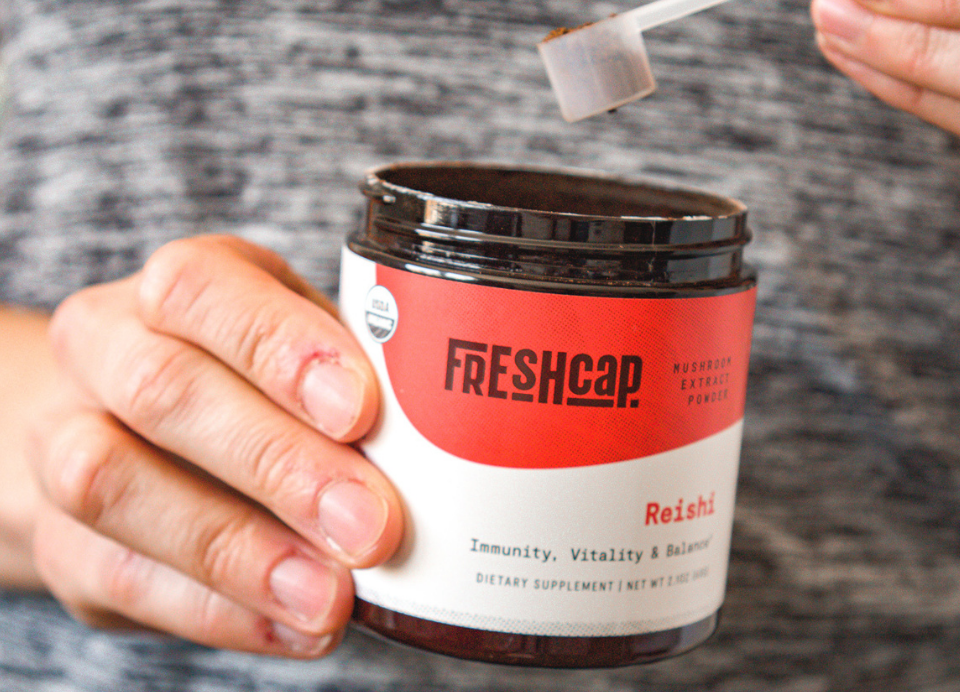
Not all Reishi supplements contain what’s listed on the label. According to one study, nearly three-quarters of the supplements tested didn’t contain the bioactive compounds that give Reishi its benefits.[51]
And that’s not the only potential problem. Because dietary supplement regulations differ by country, some products may not be pure or even safe. Obtaining Reishi mushroom from uncertain sources carries a risk of exposure to pesticides, heavy metals and other toxins, which can cause detrimental health effects.
To avoid these problems, research the available options to find a reputable source before purchasing any medicinal mushroom supplement.
Reishi Mycelium vs. Fruiting Body
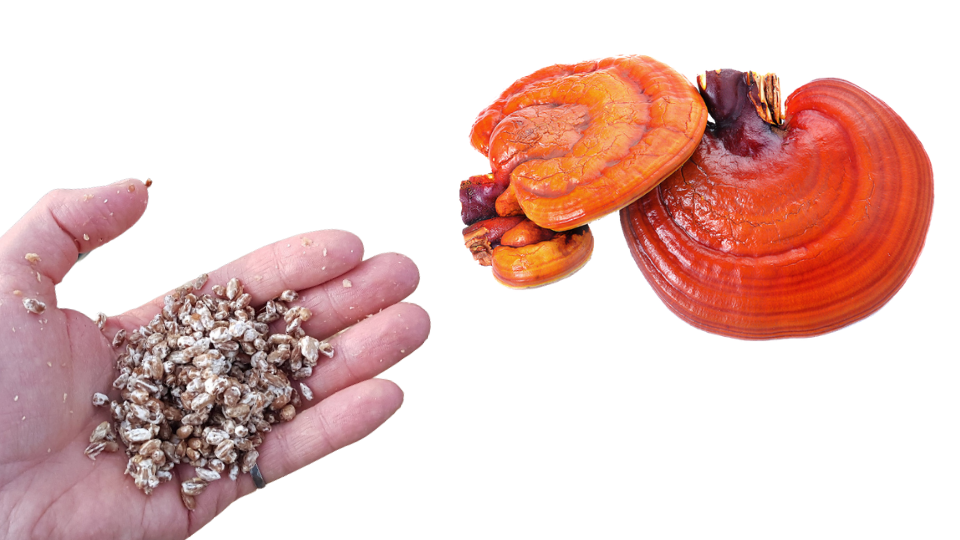
Whether a supplement contains Reishi fruiting body or only mycelium is another important consideration. Both the mycelium and the fruiting body contain Reishi’s beneficial compounds, but the fruiting body has much higher concentrations.
What about supplements that use both fruiting bodies and mycelium? Putting the two together can have its own benefits, but a lot of the mycelium in commercial products is grown on grain. This creates two problems:
- Grain-grown Reishi mycelium has much lower concentrations of bioactive compounds
- Grain winds up mixed into the final Reishi supplement formulation, greatly increasing the ratio of starch
In both cases, the resulting product is far less potent—and far less effective—than a supplement produced from Reishi fruiting bodies.
What to Look For in a Reishi Supplement
For best results, choose Reishi supplements that are:
- Organic
- Non-GMO
- Made with fruiting bodies
- Dual-extracted
Supplements containing Reishi mushroom spores may offer additional benefits. Some brands, like FreshCap, list guaranteed beta-glucan and triterpene levels on the labels to provide assurance of the contents.
Take Reishi for Your Health!
With all the potential benefits of Reishi mushrooms, it’s worth trying along with other healthy diet and lifestyle habits. Supplement regularly with a high-quality product to start busting through the barriers of stress, fatigue and illness to reach your full potential.



tony! Love Love your passion and excitement. I have been taking the lions mane and enjoy it but I’m not really noticing much of an effect that yet. I take it about once a day. I’m also been Microdosing every third day. Any information I will gratefully appreciated. I’ve also been telling my students amazing qualities of mushrooms and your company!Stay in touch!
Hey Zorina! Happy to hear you are spreading the word about the powers of mushrooms 🙂 As for the benefits, sometimes the benefits of mushrooms can appear over time and not right away. I know for me, the biggest benefit has been what doesn’t happen- ie. not getting sick as often (that has been HUGE for me, personally).
The benefits of Reishi sound amazing and I can’t wait to put in my order! I have been waiting for you to come out with Reishi all on it’s own, yay!
Awesome to hear! It really is a special mushroom 🙂 Thanks for reading!
Hi Tony, Greetings from Chilean Patagonia.
Thank you very much for the information you give us about the mushrooms you produce. I am getting started in mushroom cultivation and I am training with pleurotus ostreatus.
My idea is to grow medicinal and edible mushrooms initially on a small scale and eventually grow in production, preparing myself for my retirement.
I just saw your video: How To Grow Reishi In A “Mini Greenhouse” (EASY!) Backyard Reishi Mushroom Cultivation Step by Step, your explanation is very clear. Here we are already entering autumn so I will have to wait a few months before making this mini greenhouse in the garden.
Is indoor growing similar if I have a growth bed and controlled temperature and humidity? I have a 2 x 2 meter room that I can adapt to grow reishi.
Greetings from the far south
Francisco
Hay Tony, Iv been putting my reashi in to capsules, but I’m finding it slow going because it’s quite woody. Iv been grinding them up I a coffee grinder. Is there a way i can get this mushroom into more powder like form?